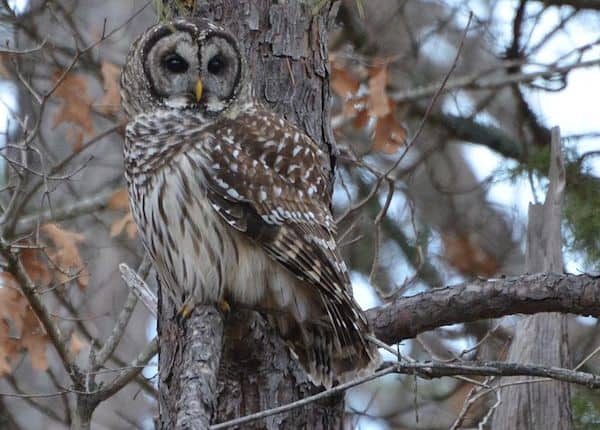A rounded, earless outline, smoky gray-brown plumage that is heavily mottled and barred with white, broad brown streaks on a white belly, and dark eyes distinguish the barred owl. Its bill and feet are yellow. Its familiar eight-hoot call gives way to raucous and sometimes frightening caterwauling in breeding season.
Listen for
Who cooks for you? Who cooks for you all? The wild hoots of the barred owl echo through swampy, deciduous woodlands throughout the South. This species is more apt to call in daylight than any other; it may call all day during overcast conditions.
Find it
Like its famous endangered cousin the spotted owl, the barred owl prefers old forest, probably in part because the large nesting cavities it requires occur in trees of ample girth. It is commonly associated with lowlands, but occupies upland sites as well. The barred owl does not migrate, but may wander in harsh winters.
Feed it
Its dark, liquid eyes give it a deceptively gentle look, but this owl is a top-of-the-line predator, taking everything from fish to rabbits. Though it does some daylight hunting, most of the barred owl’s foraging takes place at night. Anything it can kill is fair game for this medium-large owl.
Small mammals, as small as mice and up to the size of rabbits, make up at least half the barred owl’s diet. It makes acrobatic strikes after squirrels, sometimes turning completely over in flight. Birds, amphibians, reptiles, insects, and other invertebrates compose the rest of its diet.
Nesting Behavior
Most barred owls select large nest cavities, such as those formed when a large branch breaks off a hollow tree. They will also use a hollow in a broken tree trunk, as well as the nests of other raptors or squirrels.
Two to three eggs are incubated by the female alone. They hatch from 28 to 33 days later. The male feeds the family for the first two weeks of the chicks’ life, after which the female leaves them and helps bring in food.
Young owls, clothed in buff-colored down, begin venturing onto branches when they are around five weeks old, before they can fly. They give a hideous, rasping screech as a location call and may be found and observed discreetly from a safe distance. Fledglings are fed by their parents until early autumn, when they strike out to find new territory.
WOW!
In western North America, the Barred Owl is expanding its range, and in some areas this is forcing out the closely related but much smaller and rarer Spotted Owl.





Saw one of these beautiful owls today on a Northeastern Michigan parks DNR trail in Black River, MI